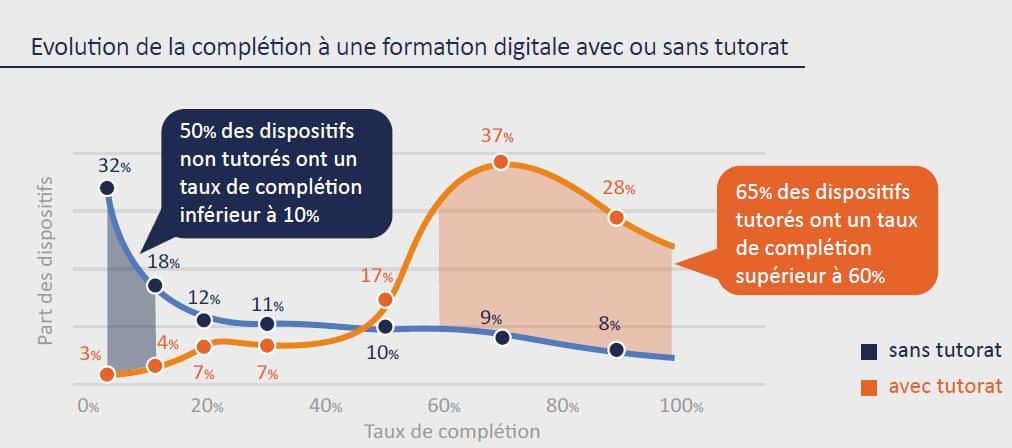The COVID-19 pandemic and successive confinements have greatly encouraged the deployment of digital learning. But now that the crisis has passed, many people are wondering: are we going to put digital tools to one side and gradually return to the 'all face-to-face' approach of the past? In other words, will digital learning become a permanent fixture on the training landscape, or will it be confined to a fallback solution like Plan B? Mathilde Istin, deputy director of the ISTF and a specialist in the digitalisation of training, believes that digital learning will be a long-term solution, provided that a few fundamentals and good practices are respected.

Before the health crisis, many people were talking about digital learning without knowing exactly what it involves. And this was true whether you were a participant, trainer or training manager. With the successive confinements and constraints of distance, digital learning has developed a great deal. Many people have been able to get a clearer idea by experiencing it first-hand. Yet even today, it is still legitimate to ask: what is digital learning? Is it virtual classes, e-learning, distance learning or even the use of digital tools during a training session?
What is digital learning?
In order to speak the same language, let's sort things out. Let's start with what digital learning is not.
Firstly, digital learning is not synonymous with the virtual classroom. This is just one of the components of distance learning courses. The characteristic of the virtual classroom is that it is synchronous, i.e. learners and trainers are together at the same time to carry out a training activity. Unlike face-to-face training, which is also synchronous, participants in virtual classes are not grouped together in the same place. They are connected remotely via an IT tool like Teams, Zoom, Classilio, Big Blue Button, etc.
Secondly, digital learning must not be confused with e-learning content. These are also just one of the components of e-learning. E-learning content has two main characteristics. It is asynchronous: the learner is alone, without the instructor. It is self-learning: corrections to learner errors are pre-programmed. For create e-learning modulesThere are authoring tools. These are dedicated software packages with advanced features, such as Articulate Storyline or Adobe Captivate. Other web-based solutions, such as Genially, are easier to learn. Asynchronous resources can also be created quickly and easily using PowerPoint.
So how do we define digital learning? There are two main definitions.
An initial "historical" definition
Learning can be described as digital learning if it includes the use of digital technology. In this case, classroom-based training using interactive tools such as Klaxoon, Wooclap or Beekast is considered to be digital. In a way, this definition is the most relevant, although it is not the most common.
A second, more widespread definition
Today, the market tends to characterise digital learning as a multimodal training programme. In other words, a training programme that combines several methods: e-learning modules, virtual classes, tutoring and sometimes face-to-face training. Another terminology is used when part of the training is classroom-based: the blended learning. This is a combination of distance learning and classroom-based courses.
The winning bets of digital learning
Initially, the training market was driven by the utopia that simple asynchronous self-training modules, i.e. e-learning modules, could in themselves replace full-blown training courses. At the time, distance learning had a bad reputation, because it threatened to replace face-to-face training and therefore to do away with the profession of trainer.
Then, the lexicon of distance learning was enriched with new terms: "rapid learning", "learning game"... Today, thanks to a diversity of methods, we have a different view of digital learning. Training courses have become well thought-out combinations of different teaching methods. The idea is to capitalise on the advantages of each. Distance learning no longer replaces face-to-face learning at all costs (at least when health conditions do not require it). On the contrary, distance learning complements face-to-face learning and even optimises it, particularly through blended learning. Similarly, synchronous learning reinforces asynchronous learning.
A number of trainers, managers and training directors have had the opportunity to experience this for themselves, each in their own field. rolethis type of multimodal distance learning.
"Today, digital learning has earned its stripes.
As a result, digital learning is no longer perceived as a different business or as a less high-quality service requiring heavy financial investment. It took time to experiment first, then to practise, before finally integrating high-quality digital learning into the practices of those involved in training. But for this to happen, digital learning must respect certain fundamentals.
The three fundamentals of engaging digital learning
Every year, the ISTF surveys 400 training professionals on their approach to digital learning. In its 8e edition, this survey highlights the three foundations of engaging digital training. In other words, the three main factors in learner engagement during training.
In the field of training, the commitment of learners is what enables them to be taken along from the beginning to the end of the course. The aim is to arouse and maintain their interest throughout the course. Engagement is measured via Completion rate. This is the ratio between the number of learners who complete their training and the number of learners enrolled.
1/ Training linked to the learner's business issues
Behind this first commitment factor lies the notion of time to business. The purpose of training is to enable participants to be effective in their jobs today or in their career plans, i.e. their jobs tomorrow. To achieve this, the company needs to be able to diagnose or gather information on needs. And, above all, to immediately offer digital training in line with these needs.
"Training time to business"
Let's take the example of training sales staff in a new product throughout France. If we were to consider face-to-face training only, the required action could only be deployed after organising travel, recruiting or planning the trainers, as well as the physical presence of the participants. And that's just the logistics. The training will certainly come after the sales staff have needed it, because in the meantime they will have discovered the new features for themselves, so that they can be effective in the field. Their commitment to the training will therefore be low, because it will no longer be necessary. time to business. It's quite the opposite with, for example, a virtual classroom: a short, synchronous, remote training session, using a video tool such as Teams or Zoom. The training team gains in responsiveness to participants' expectations.
For the company, this ability to deliver training quickly, facilitated by the digitisation of training, goes hand in hand with anticipating skills needs and therefore managing the skills of its employees. But for the training department and management, assessing the achievement of learning objectives after training is proving difficult in practice. And yet, "what can't be measured can't be managed".to borrow a phrase popularised by management specialist Peter Drucker. This is why training is now more and more directly geared towards the validation of skills, thanks in particular to micro-certifications, rather than simply targeting educational objectives.
To put it plainly: managing training through skills means first and foremost being able to measure and ultimately certify them.
2/ Certification
In France, the question of certification is often limited to an economic aspect, since it determines the eligibility of the training action for the CPF (Personal Training Account). The CPF allows participants to finance some or all of their training independently. However, beyond this economic aspect, what the learner is looking for is genuine professional recognition of the skills acquired or enhanced by training.
Unsurprisingly, the ISTF survey shows that obtaining a qualification is the second most important factor in people's commitment to training. And this is true whether or not the qualification is national, and therefore eligible for the CPF. In addition to the qualifications registered in the various France Compétences directories, there are also private certifications and badges that certain training organisations or companies offer on completion of their training courses.
In response to these changes in the training market, digital platforms known as micro-credentials have appeared in France, such as Procertif, Credly and BCdiploma. They enable the validation of skills to be materialised via secure digital certificates.
3/ The presence of a tutor
Tutor support is the third most important factor in learner engagement during digital training. It influences both the start and the end of the course. When all or part of the training takes place remotely, the trainer's challenge is to engage as many learners as possible and get as many of them as possible to complete the course. Our 2021 survey shows that tutoring, i.e. the support provided by the trainer or a tutor during the course, has a considerable impact on this commitment.

Without tutoring, one out of every two schemes will involve no more than 10 % of participants. This means that for half of the courses launched, nine out of ten learners will not complete their course. With tutoring, on the other hand, more than six out of ten courses will take more than 60 % of participants to the end of their course.
The possibility for learners to interact with the trainer throughout the multimodal course is undoubtedly what will most differentiate the quality of distance learning in the coming years.
Finally, the prospects for digital learning are as great as the training needs are numerous. They can be found in every sector of activity and at every level of the hierarchy. As long as we realise that the quality of digital learning depends first and foremost on the men and women who design and run the training courses. The role of the trainer is even more central in distance learning than in face-to-face training. Those who take up this challenge will be the winners of digital learning.


